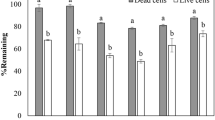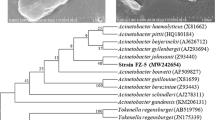Abstract
Benzene has a wide range of industrial applications, but it is also a major source of environmental pollution. The most eco-friendly/cost-effective method of remediation is biodegradation. In the present study, we used a variety of microbial strains in different combinations on a selection of substrate concentrations to determine the most effective degradation processes. Bacterial strains of pure culture (L4, N3, and N6) were isolated from oil sludge in both Luria–Bertani buffer (LB) and nutrient broth media, and identified by 16S-rRNA analysis (≥98% similarity). The degradation experiments were performed using different combinations of bacterial strains (L4, N3, N6, L4 + N3, L4 + N6, N3 + N6, and L4 + N3 + N6) in modified carbon-free media with different concentrations of benzene as a carbon source (60, 100, and 160 mg l−1) at 30 °C. The isolates of L4 (Acc no: FJ686821), N3 (FJ686825) and N6 (FJ868628) were identified as Bacillus spp. using 16S-rRNA gene sequence analysis. All combinations of isolates have the capacity to degrade benzene. However, the L4 + N3 combination was more efficient than the other mixed or single cultures. In the presence of N6 isolate, the degradation rate of benzene decreased, possibly due to inter- and/or intra species interaction amongst the bacteria. The kinetic parameters ‘K m’ of the Lineweaver–Burk regressions conducted as part of this experiment showed that the lower the level of K m was, the better the biodegradation achieved. The results of this study showed that the use of Bacillus strains in benzene decomposition is feasible. In addition, different strain combinations exhibited different degradation patterns, which are attributed to the most efficient mixed cultures of Bacillus spp.



Similar content being viewed by others
Abbreviations
- μ:
-
Specific growth rate
- μmax :
-
The maximum specific growth rate
- [S]:
-
Substrate concentration (mg l−1)
- K m :
-
Kinetic constant characteristic of the particular enzyme and substrate
References
Alvarez PJJ, Vogel TM (1991) Substrate interactions of benzene, toluene, and para-xylene during microbial degradation by pure cultures and mixed culture aquifer slurries. Appl Environ Microbiol 57:2981–2985
Baldwin BR, Mesarcit MB, Nies L (2000) Broad substrate specificity of naphthalene- and biphenyl-utilizing bacteria. Appl Microbiol Biotechnol 53:748–753
Camper AK, McFeters GA (1979) Chlorine injury and the enumeration of waterborne coliform bacteria. Appl Environ Microbiol 37:633–641
Chang MK, Voice TC, Criddle CS (1993) Kinetics of competitive inhibition and cometabolism in the biodegradation of benzene, toluene, and pxylene by two pseudornonas isolates. Biotechnol Bioeng 41:1057–1065
Collins LD, Daugulis AJ (1999a) Benzene/toluene/p-xylene degradation. Part I. Solvent selection and toluene degradation in a two-phase partitioning bioreactor. Appl Microbial Biotechnol 52:354–359
Collins LD, Daugulis AJ (1999b) Benzene/toluene/p-xylene degradation. Part II. Effect of substrate interactions and feeding strategies in toluene/benzene and toluene/p-xylene fermentations in a partitioning bioreactor. Appl Microbiol Biotechnol 52:360–365
Cubitto MA, Morán AC, Commendatore M, Chiarello MN, Baldini MD, Siñeriz F (2004) Effects of Bacillus subtilis O9 biosurfactant on the bioremediation of crude oil-polluted soils. Biodegradation 15:281–287
Das K, Mukherjee AK (2007) Crude petroleum-oil biodegradation efficiency of bacillus subtilis and Pseudomonas aeruginosa strains isolated from a petroleum-oil contaminated soil from north-east India. Bioresour Technol 98:1339–1345
Dowd RM (1984) Leaking underground storage tanKm. Environ Sci Technol 18:309A
Dubey RC, Maheshwari DK (2005) Practical microbiology. 1st edn (Reprint). S. Chand and Company Ltd., New Delhi, pp 10–25
Furukawa K, Simon JR, Chakrabarty AM (1983) Common induction and regulation of biphenyl, xylene/toluene, and salicylate catabolism in Pseudomonas paucimobilis. J Bacteriol 154:1356–1362
Grady CPL Jr, Smets BF, Barbeau DS (1996) Variability in kinetic parameter estimates: a review of possible causes and a proposed terminology. Water Res 30:742–748
Gunaseelan A, Cowan R (2003) Substrate inhibition kinetics for toluene and benzene degrading pure cultures and a method for collection and analysis of respirometric data for strongly inhibited cultures. Biotechnol Bioeng 83:798–809
Hyman MR, Sansome-Schmith AW, Shears JH, Wood PM (1985) A kinetic study of benzene oxidation to phenol by whole cells of Nitrosomonas europea and evidence for the further oxidation of phenol to hydroquinone. Arch Microbiol 143:302–306
Jannasch H, Egli T (1993) Microbial growth kinetics: a historical perspective. Antonie van Leeuwenhoek 63:213–224
Jean J-S, Tsai C-L, Ju S-H, Tsao C-W, Wang S-M (2002) Biodegradation and transport of benzene, toluene, and xylenes in a simulated aquifer: comparison of modeled and experimental results. Hydrol Process 16:3151–3168
Jean J-S, Lee M-K, Wang S-M, Chattopadhyay P, Maity JP (2008) Effects of inorganic nutrient levels on the biodegradation of benzene, toluene, and xylene (BTX) by Pseudomonas spp. in a laboratory porous media sand aquifer model. Bioresour Technol 99:7807–7815
Kim SB, Park CH, Kim DJ, Jury WA (2003) Kinetics of benzene biodegradation by Pseudomonas aeruginosa: parameter estimation. Environ Toxicol Chem 22:1038–1045
Kobal VM, Gibson DT, Davis RE, Garza A (1973) X-ray determination of the absolute stereochemtstry of the initial oxidation product formed from toluene by Pseudomonas putida 39/D. J Am Chem Soc 95:4420–4421
Kova′rova′-Kovar K, Egli T (1998) Growth kinetics of suspended microbial cells: from single-substrate-controlled growth to mixed-substrate kinetics. Microbiol Mol Biol Rev 62:646–666
Lee EY, Jun YS, Cho KM, Ryu HW (2002) Degradation characteristics of toluene, benzene, ethylbenzene, and xylene by Stenotrophomonas maltophilia T3-c. J Air Waste Manage Assoc 52:400–406
Mallakin A, Ward O (1996) Degradation of BTEX compounds in liquid media and in peat biofilters. J Ind Microbiol 16:309–318
Marr EK, Stone RW (1961) Bacterial oxidation of benzene. J Bacteriol 18:425–430
Medina-Moreno SA, Huerta-Ochoa S, Gutierrez-Rojas M (2005) Hydrocarbon biodegradation in oxygen-limited sequential batch reactors by consortium from weathered, oil-contaminated soil. Can J Microbiol 51:231–239
Mulligan CN, Yong RN, Gibbs BF (2001) Surfactant-enhanced remediation of contaminated soil: a review. Eng Geol 60:371–380
Natarajan MR, Lu Z, Oriel P (1994) Cloning and expression of a pathway for benzene and toluene from Bacillus stearothermophilus. Biodegradation 5:77–82
Oh YS, Bartha R (1997) Construction of a bacterial consortium for the biofiltration of benzene, toluene and xylene emissions. World J Microbiol Biotechnol 13:627–632
Oh YS, Choi SC (1997) Characterization of BTX-degrading bacteria and identification of substrate interactions during their degradation. J Microbiol 35:193–199
Oldenhuis R, Kuijk L, Lammers A, Janssen DB, Witholt B (1989) Degradation of chlorinated and non-chlorinated aromatic solvents in soil suspensions by pure bacterial cultures. Appl Microbiol Biotechnol 30:211–217
Olsen RH, Kukor JJ, Kaphammer B (1994a) A novel toluene-3-monooxygenase pathway cloned from Pseudornonas pickettii PKO1. J Bacteriol 176:3749–3756
Olsen RH, Mikesell MD, Kukor JJ (1994b) Enumeration and characterization of BTEX-degrading bacteria from hypoxic environments functional with mixed electron acceptors. Res Microbiol 145:47–49
Olsen RH, Mikesell MD, Kukor JJ, Byrne AM (1995) Physiological attributes of microbial BTEX degradation in oxygen-limited environments. Environ Health Perspect 103:49–51
Paje MLF, Neilan BA, Couperwhite L (1997) A Rhodococcus species that thrives on medium saturated with liquid benzene. Microbiology 143:2975–2981
Reardon KF, Mosteller DC, Rogers JB (2000) Biodegradation kinetics of benzene, toluene, and phenol as single and mixed substrates for Pseudomonas putida F1. Biotechnol Bioeng 69:385–400
Reardon KF, Mosteller DC, Rogers JB, DuTeau NM, Kim K-H (2002) Biodegradation kinetics of aromatic hydrocarbon mixtures by pure and mixed bacterial cultures. Environ Health Perspect 110:1005–1011
Shim H, Yang ST (1999) Biodegradation of benzene, toluene, ethylbenzene, and o-xylene by a coculture of pseudomonas putida and pseudomonas fluorescens immobilized in a fibrous-bed bioreactor. J Biotechnol 67:99–112
Shim H, Yang ST (2002) BTEX removal from contaminated groundwater by a co-culture of pseudomonas putida and pseudomonas fluorescens immobilized in a continuous fibrous-bed bioreactor. J Chem Technol Biotechnol 77:1308–1315
Shim H, Yang ST (2006) Kinetics of BTEX biodegradation by a coculture of Pseudomonas putida and Pseudomonas fluorescens. J Environ Eng Manage 16:309–317
Shim H, Shin E, Yang ST (2002) A continuous fibrous-bed bioreactor for BTEX biodegradation by a co-culture of Pseudomonas putida and Pseudomonas fluorescens. Adv Environ Res 7:203–216
Shim H, Hwang B, Lee SS, Kong SH (2005) Kinetics of BTEX biodegradation by a coculture of Pseudomonas putida and Pseudomonas fluorescens under hypoxic conditions. Biodegradation 16:319–327
Shirai K (1986) Screening microorganisms for catechol production from benzene. Agric Biol Chem 50:2875–2880
Tan HM, Mason JR (1990) Cloning and expression of the plasmid-encoded benzene dioxygenase genes from P. putida ML2. Fems Microbtol Lett 72:259–264
Toledo FL, Gonzalez-Lopez J, Calvo C (2008) Production of bioemulsifier by Bacillus subtilis, Alcaligenes faecalis and Enterobacter species in liquid culture. Bioresour Technol 99:8470–8475
Turner LH (1995) Vapor-liquid equilibrium of highly non-ideal aqueous organic system. Ph.D. thesis, Rutgers university, New jersey, USA
Weelink SAB (2008) Degradation of benzene and other aromatic hydrocarbons by anaerobic bacteria. Ph.D. thesis, Wageningen university, Wageningen, Netherlands
Whang LM, Liu PW, Ma CC, Cheng SS (2008) Application of biosurfactants, rhamnolipid, and surfactin, for enhanced biodegradation of diesel-contaminated water and soil. J Hazard Mater 151:155–163
Winstanley C, Taylor SC, Williams PA (1987) pWW174: a large plasmid from Acinetobacter calcoaceticus encoding benzene catabolism by the ß-ketoadipate pathway. Mol Microbiol 1:219–227
Yasuda Y, Katoh S, Inoue Y, Shiomi N (2003) A bioremediation method based on self-immobilization of cells in shallow layer of soil. J Chem Eng Jpn 36:216–219
Yu H, Kim BJ, Rittmann BE (2001a) The roles of intermediates in biodegradation of benzene, toluene, and p-xylene by Pseudomonas putida F1. Biodegradation 12:455–463
Yu H, Kim BJ, Rittmann BE (2001b) A two-step model for the kinetics of BTX degradation and intermediate formation by Pseudomonas putida F1. Biodegradation 12:465–475
Ziffer H, Jerina DM, Gibsox DT, Kobal Val M (1973) Absolute stoichiochemistry of the (+)-cts-l, 2-dihydroxy-3-methylcyclohexa-3.5-diene produced from toluene by Pseudomonas putida. J Am Chem Soc 95:4048–4049
Acknowledgments
This work was supported by the National Science Council in Taiwan (NSC No. NSC 96-2116-M-006-003).
Author information
Authors and Affiliations
Corresponding author
Rights and permissions
About this article
Cite this article
Liu, JH., Maity, J.P., Jean, JS. et al. Biodegradation of benzene by pure and mixed cultures of Bacillus spp.. World J Microbiol Biotechnol 26, 1557–1567 (2010). https://doi.org/10.1007/s11274-010-0331-9
Received:
Accepted:
Published:
Issue Date:
DOI: https://doi.org/10.1007/s11274-010-0331-9




